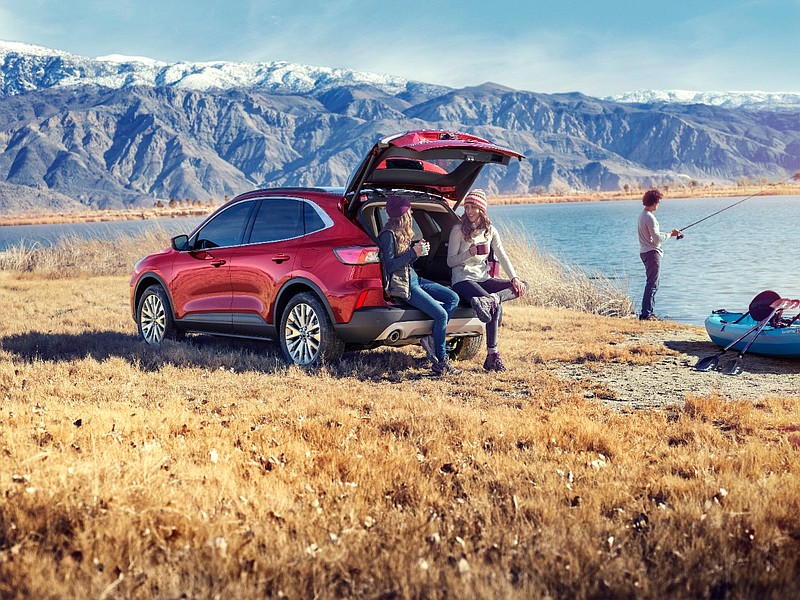As Ford transitions from cars to SUVs the all-new, 2020 Escape presents a fascinating fork in the road.
On one path, the new Escape offers a high degree of comfort, technology, and safety at attractive, entry-level pricing. It's a good choice for older folks who appreciate a higher ride vantage and slide-in ease of entry. It's also a smart choice for young families who need flexibility and cargo space.
Powered by a turbocharged, 1.5-L, three-cylinder engine with cylinder deactivation technology, the new Escape delivers more power than competitors - 180 hp vs 150 or less - but below-par fuel economy and above-average noise and vibration keep it from being ranked with the best in this class, such as the Mazda CX-5, Toyota RAV4, and Honda HR-V.
On the other hand, competitors start at about $600 to $800 more. Ford is offering sales incentives and area Ford dealers are adding aggressive discount pricing, so if dropping that monthly payment by $50 to $100 or more is an issue, the Escape is worth a look.
On the other path, however, Ford's expertise with hybrid technology will soon make the Escape the smartest play in the segment.
Hybrid? Really?
Ok, let's deal with this right now. I know you don't know much about electric vehicles, and probably don't care to, but bear with me for a few moments and I'll explain why what you don't know is costing you thousands of dollars in fuel, maintenance, and equity.
Point A: Electric motors run cooler, have fewer moving parts, run much, much longer and are astronomically more efficient than an internal combustion engine.
The best running gas engine on the planet (built by Toyota) achieves a thermal efficiency of 38 percent. That means 62 percent of the energy is lost to heat (along with friction the enemy of all things mechanical) and tailpipe emissions. Most gas engines run at 30 percent or less.
Because they use compression ignition, as opposed to spark ignition, diesel engines reach efficiencies of 45-55 percent, so they get better mileage, but still pour out tons of exhaust.
At the same time, electric motors run, like, forever. I once talked to a team of Nissan engineers who disassembled a Leaf at 250,000 miles. They found zero, no, none, nada, addressable wear issues. We think 250,000 miles on a car is amazing, but we don't really know the life expectancy of an electric motor. Half a million miles? A million?
The funny thing about electric motors is that the more powerful they are, the more efficient they become. A 10-hp electric motor is about 85 percent efficient, a 100-hp one is nearly 96 percent.
Point B: An electric car's battery back is nothing like a gas car's starter battery, which can fail without warning. A battery pack is made up of dozens of individual cells, so the failure of one does not mean the failure of all. Toyota has been putting battery packs in cars since 1997 and has yet to record a catastrophic failure. What happens is that the packs' capacity slowly diminishes (which can be periodically monitored) The car continues to operate, usually for 12-15 years, before the pack has to be replaced.
Good news for the third or fourth owner: Batteries are getting cheaper and so is the cost of replacing them. They are also getting smaller. The battery pack in a new Escape is about the size of a briefcase and weighs a third of the ones Ford first starting putting in the Hybrid Fusion a decade ago. Consumer Reports rated that vehicle as one of the most reliable sedans. Ever.
Point C: Here's the big one. Electric motors take an enormous amount of work off the internal-combustion driveline, an estimated 25-30 percent, according to which research report one reads. That means the gas engine in a hybrid with 100,000 miles on it has only done 75,000 miles worth of work.
But wait, there's more. Ford plans to bring out a plug-in hybrid Escape this spring. Early buzz is that it will allow 30 miles of pure-electric driving every day. If your daily commute is less than 30 miles, you will only fill the gas tank for vacations.
What if you drive more than 30 miles? When needed, the gas engine will seamlessly take over. The other is that 30 miles, times 5 days a week, times 52 weeks means that every year you will drive 7,800 miles without engine wear, cooling system wear, exhaust system wear, and very little brake system wear (electrics recapture that energy rather than burning up discs and rotors).
So you drive that car for four years and put 60,000 miles on it. Half those miles were with the engine off, and a third of the remainder was done by the electrical components. You've really only put 20,000 miles on the engine.
Oh, and you will have done the planet a really, really big favor.
Hybrids cost too much
Not any more.
A really nicely equipped 2020 Escape SE, with a slick tablet interface for Apple CarPlay160 and Android Auto, heated front seats, dual-zone temperature control, torque vectoring, lane-keeping, remote entry, push-button start, and a nearly complete driver assist package starts at $27,105 (but you can get it for less).
The SE Hybrid, which comes with a much smoother running 2.5-L I-4 engine and even more features, is $1,100 more. The combination of power sources nets 200 horses. Delivering 44 mpg city and 37 highway, 41 combined. That's a little better than the RAV4 hybrid.
And you get a cargo area that holds four golf bags. With all due respect - until we see the pricing and features on the plug-in - that's a value champion.
If you want that car this week, however, you will have to wait. Not many are around in this neck of the woods. Dealerships, after all, are not in the business of selling people cars they ought to buy; rather, they stock the ones consumers will buy.
Change is in the wind
"We don't have any Escape Hybrids in inventory right now, but we have several ordered," said Mike Terrell of McClarty Ford. "We think the timing is here. Younger buyers are more accepting of hybrids, but the older generations have not yet embraced them, but that's beginning to change."
Whether it's gas- or hybrid-powered vehicles buyers seek, Ford laid a solid foundation with the fourth-generation Escape. It has attractive lines, a roomy interior, a quiet ride, nimble handling and a model lineup broad enough to accommodate a variety of needs and budgets. We suspect that the redesigned chassis, which incorporates high-tensile steel and state-of-art weld assembly, will fare well in crash testing.
Bottom line
Ford stepped into one of the most competitive auto segments with an entry that promises to be a player for years to come.


